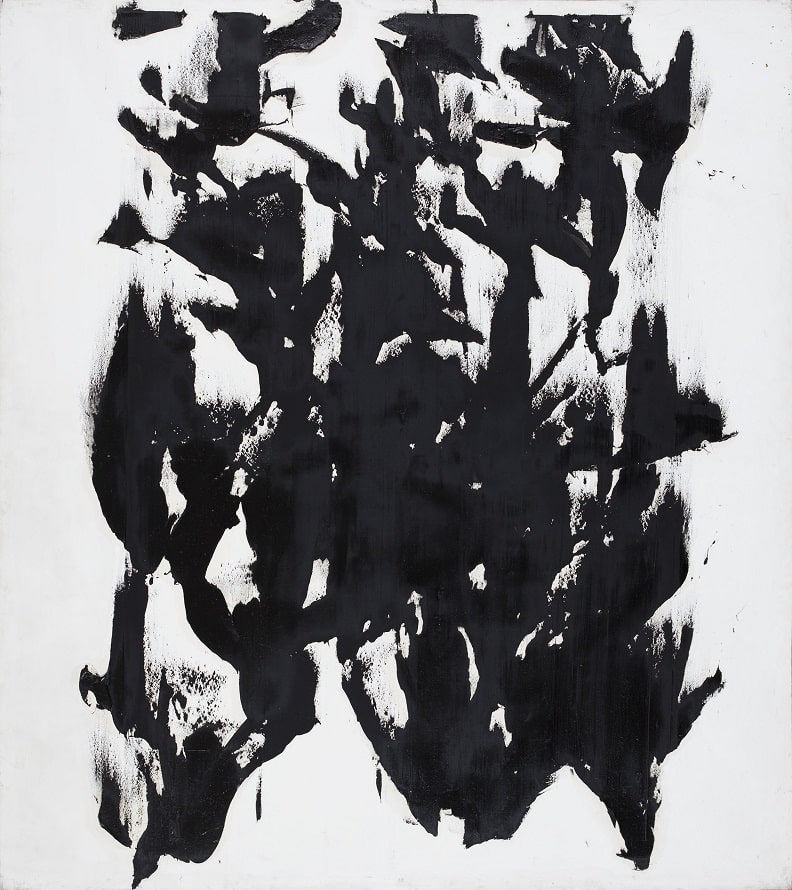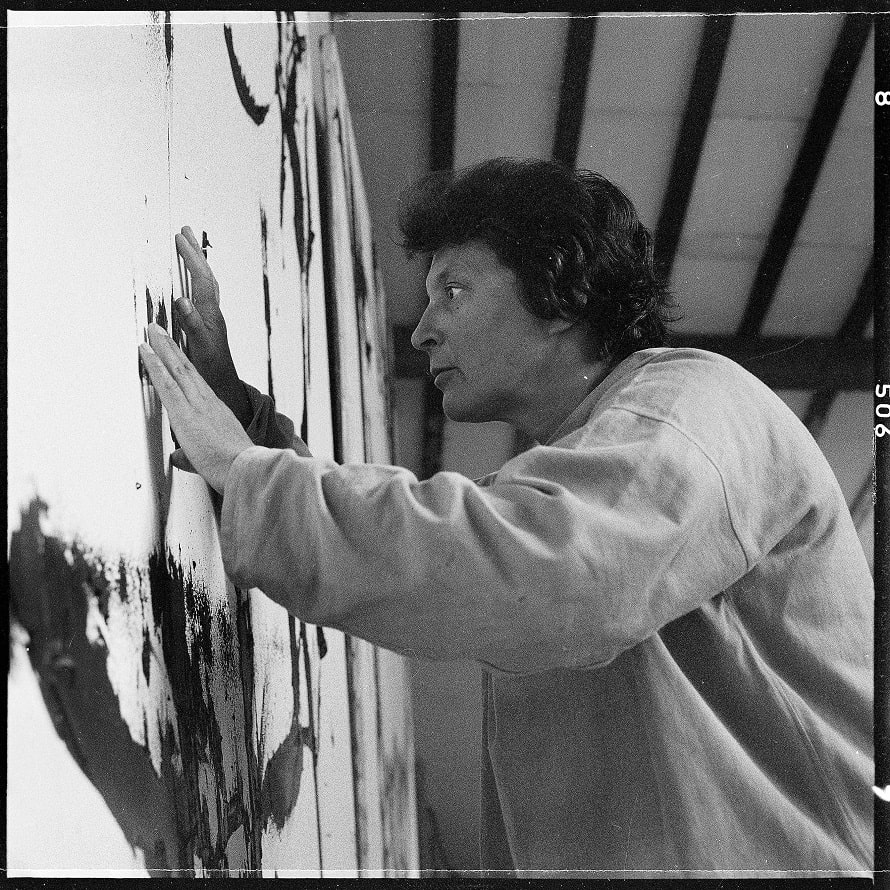Neue Nationalgalerie shows the exhibition Kraftfelder by the artist Judit Reig since 30 June 2023. On the occasion of the centenary of the artist’s birth and the donation of three major works by Judit Reigl, the Neue Nationalgalerie is presenting the first solo museum exhibition of the Hungarian-French artist in Germany. With the donation, the Nationalgalerie is the first public collection in Germany to own works by the important painter, who was closely associated with French Informel in the 1950s.
Fig. above: Judit Reigl in ihrem Atelier in Marcoussis, 1964 © Fonds de Dotation Judit Reigl
With this overview of Reigl’s oeuvre, the Neue Nationalgalerie dedicates itself to one of the most important European painters of the second half of the 20th century. On display are sixteen, mostly large-format paintings from the simultaneously abstract and figurative oeuvre of Reigl (1923 – 2020). Born in Hungary, she first studied at the Academy of Arts in Budapest. In 1950, she fled her home country due to the rise of Stalinism and settled in Paris. While her early, mostly mysterious paintings were still committed to Surrealism, she increasingly turned to abstraction in the mid-1950s. Again and again, figurative elements can be found in her paintings, which culminated in the torsos of the “Mensch” series in the mid-1960s. In addition to the paintings “Kraftfeld” (1959), “Massenschrift” (1960) and the large-format triptych “Mensch” (1967-1969), which will be presented to the Nationalgalerie as a generous donation from the Fonds de dotation Judit Reigl, the exhibition will show central works from the 1950s to the 1980s, providing a comprehensive insight into the artist’s multi-layered creative phases.
On the basis of the paintings on display, visitors can follow Reigl’s work from surrealism to both abstract and figurative gestural painting. The painting “Incomparable Pleasure (Volupté incomparable)” (1952/53), for example, features abstract elements alongside classical surreal, collage-like motifs, which increasingly came to the fore in Reigl’s subsequent paintings. Reigl became a link between two abstract movements of the time, the Abstract Expressionism of the New York School around Jackson Pollock and Willem de Kooning and the Paris School, which was influenced by Wols and Georges Mathieu. Their works were later subsumed under the terms Lyrical Abstraction, Tachisme or Informel.

Since the end of the 1940s, Reigl worked in series. Throughout her life, chance and the impulsive process of painting were among her basic principles. This first became clear in her series “Ausbruch” (Outbreak) and “Kraftfeld” (Force Field), which were created from the mid to late 1950s. Reigl often applied the bright, saturated colours to the canvas in various layers with her bare hands. Reigl stopped using normal brushes as early as 1951. After applying the paint, she worked the surface with a razor blade, a blade or a bent curtain rod.
The time factor plays a decisive role in her “Guano” paintings (1958-65), in which she reworks old, splattered canvases. At the same time, she created her “Massenschriften” (1959-65), spontaneous compositions of forms from which figurative elements gradually developed. These finally culminate in the series “Mensch” (1966-1972). For Reigl, her “Humans” were universal creatures, neither man nor woman, possibly both at the same time – she herself never accepted a dichotomous conception of the sexes. Afterwards, Reigl returned to abstraction with her large-scale “Entfaltungen” (1973-1985). Nevertheless, the human figure remains present in her work until the end.
In her artistic work, Reigl ignored the supposed opposition between abstraction and figuration; she did not belong to any artistic association. Throughout her life, she explored new painting techniques and constantly renewed her artistic approach. Her works evolve from explosive, gestural applications of paint to performative, dance-painting processes. The physical process of painting, based on feeling and spontaneity, is as important to her as the technical aspect, from the choice of canvas to the making of her own painting tools. Therein lies the value of her contribution to the art of the second half of the 20th century.
The exhibition is accompanied by a catalogue published by DCV Verlag (German/English, 88 pages, museum edition 19 euros; bookstore edition 28 euros). It is the first publication about the artist in German.
Kuratiert von Maike Steinkamp, wissenschaftliche Mitarbeiterin Neue Nationalgalerie.
WHERE?
Neue Nationalgalerie
at the Kulturforum
Potsdamer Straße 50
10785 Berlin
WHEN?
Opening: Thursday, 29 June, 7 pm
Exhibition dates: Friday, 30 June – Sunday, 8 October 2023
Tue – Wed 10 am – 6 pm, Thu 10 am – 8 pm, Fri – Sun 10 am – 6 pm






